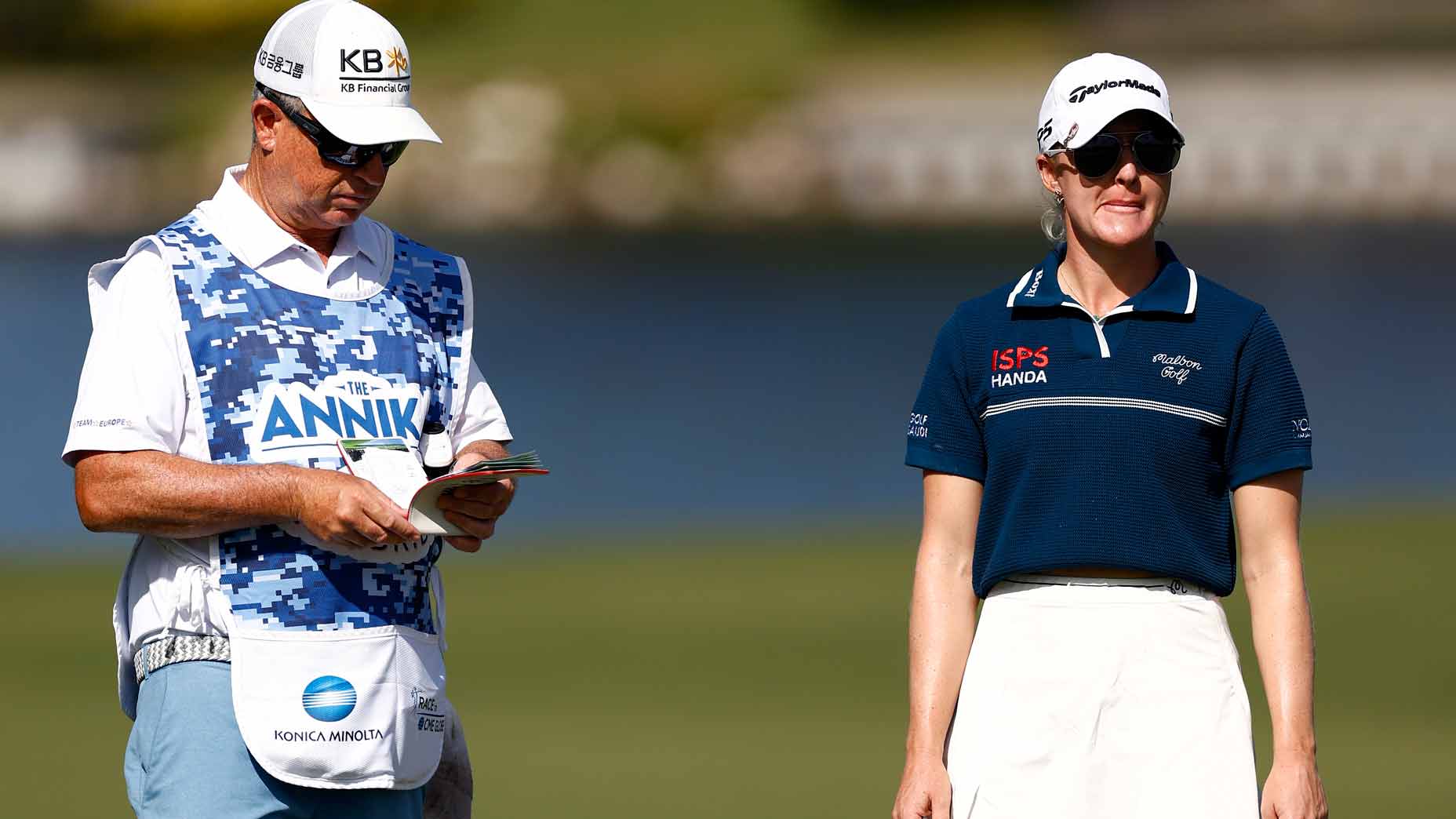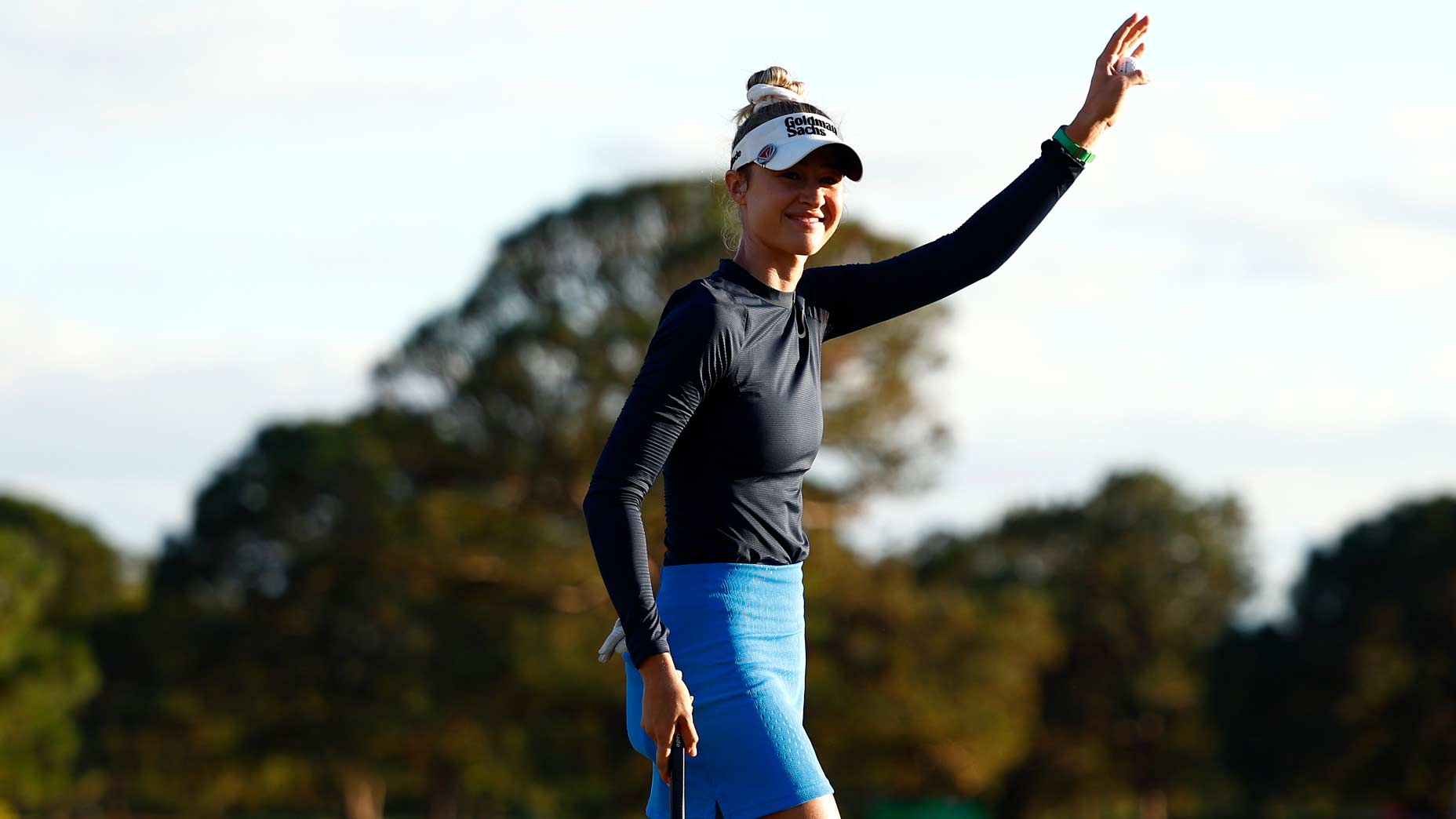Nick Piastowski

Nelly Korda and caddie Jason McDede at last year’s CME Group Tour Championship.
Getty Images
NAPLES, Fla. — Angel Yin, one of professional golf’s most perky souls, says she felt like she was being put to sleep, though the sedative most certainly wasn’t her golf, nor the golf course she was playing.
It was the effort being put forth by some other folks, whose names she safely kept hidden, but it’s OK to say they made viewing blades of grass sprouting up beneath her a more lively game.
“When I first came out on tour, I could take a nap,” Yin said.
“It was terrible.”
Yes, the subject here is slow play, whose name mostly tells you everything: Play is slow — and that can frustrate. It came to light last weekend, at the LPGA’s Annika tournament, where the golf bogged down, rounds stretched well past five hours, pros battled darkness — and Charley Hull, a victim and not a perpetrator, went viral with some of her thoughts on the matter.
“It was crazy,” she began. “I’m quite ruthless, but I said, listen, if you get three bad timings, — every time it’s a two-shot penalty — if you have three of them, you lose your tour card instantly; go back to Q-School. I’m sure that would hurry a lot of people up and they won’t want to lose their tour card.
“That would kill the slow play, but they would never do that.”
When asked if it was in issue, Hull continued on.
“It’s ridiculous and I feel sorry for the fans how slow it is out there,” she said. “We were out there for five hours and 40 minutes yesterday. We play a four-ball at home, on a hard golf course, and we’re round in three and a half, four hours.
“It is pretty crazy.”
Of course, this is nothing new. You’ve read about this before. It’s raised on both the women’s tours and the men’s tours. There are fines and stroke penalties, too, but here we are. At this point, you could maybe call it just SP and people would know what you were inferring. So you then wonder: How, again, hasn’t this been solved?
Helluva question.
Ahead of this week’s season-ending CME Group Tour Championship, some of the LPGA’s best and brightest dug more into Hull’s thoughts. They were asked whether slow play is an issue, and how they’d solve it if they thought it was.
Opposingly to the subject, the responses came quickly.
Is slow play an issue?
“So I have my opinions,” Yin said when asked. As did Nelly Korda, Lexi Thompson, Lydia Ko and others. And clearly, Hull.
We’ll try to start positively. To Yin, there’s been some progress, though perhaps that was a (s)low bar to clear. After last week, the memory is also fresh, so you expect the answers to sound more dramatic. Time hasn’t healed the wound, so to speak.
‘I’m quite ruthless’: Charley Hull’s LPGA slow-play fix shows little mercy
By:
Zephyr Melton
Then again, as noted above, here we are again, and players weren’t blind to that. Ruoning Yin said last week was “pretty rough.” Jeeno Thitikul said last week’s five-and-a-half-hour rounds were “a little too much.” Thompson expressed that rounds shouldn’t extend past four and a half hours — and argued the problem has actually worsened.
Korda said if she were a fan, she’d be annoyed.
Notably, she’s also one of the tour’s speediest players — and it’s here where maybe we can find some solutions.
“Jason actually has to slow me down sometimes,” the world No. 1 said of her caddie, Jason McDede. “I don’t know. Just always like my first instinct is just the best instinct. You see it, you hit it.
“Today with Charley — Charley and I played together today again, three rounds in a row, practice round. She was talking, and it’s like either a 5 [iron] or a 6 [iron], like you got two options. It’s either wind is off your right or wind is off your left, wind is into, wind is down. You can’t — it’s just people just try to overcomplicate it.
“I just always say your first instinct is your best instinct, I would say. Just be ready when it’s your turn.”
Then there’s Ko.
One of the tour’s more thoughtful minds, she said the issue has its layers.
“Nobody, I mean, even if you’re the biggest golfing fan, nobody wants to be out there for as long as possible,” Ko said. “Sometimes like last week, it was a really difficult golf course with fast greens and undulating greens.
“Even if you’re playing well, but you hit one shot out of position, it’s going to take a lot more time than the person hitting it in the middle of the green and two-putt. And even two-putts around a golf course like Pelican didn’t come easy.
Nelly Korda storms back at Pelican for 7th win of the season
By:
Jack Hirsh
“Yes, it depends on the situation. U.S. Women’s Opens tend to take longer because we have a bigger field. It is really one of the toughest tournaments we play all year.
“So just is case by case.”
Most certainly. But could that be solved?
The last word here is for Ewing. This week is her last. She’s retiring.
And next year at this time?
“I’m going to be hopping in a golf cart zipping around in my retirement,” she said.
She then continued.
“You know, it’s always been a topic of conversation since I’ve been on Tour. I do think with some players it’s an issue. You have your fast players and we all know who those are.
“I don’t have any answers, but it definitely is hard to play with at times, and I’m sure it’s super hard for the rules officials. Every year at the end of the year, they’re like, how are we going to make this better?
“You know, people are playing for their livelihood so I get it why people take their time. I think there is a line we have to draw.”
How do you solve slow play?
Let’s try. Let’s draw that line.
What say you, Angel? The floor’s yours.
Look at spacing, Yin said.
Rory’s tearful finale, Nelly’s surprise, a ‘ridiculous’ slow-play fix | Monday Finish
By:
Dylan Dethier
“Because we get up to the tee box and we’re already delayed and we’re in a morning tee time,” she said. “So how can that fall onto a player? And that’s also going back to where I think we can improve as a tour, a small issue. I can’t point fingers too much, but there are certain types of people who I feel like they should be able to manage that better. I think the easiest way to point fingers without thinking too deep into it is players slow-play, but it takes a lot for the schedules to fit, and if the schedules don’t fit, then we’re just sitting on a hole. And I think that’s where it’s showing up. At the U.S. Open, we had a slow hole where there was like four groups stacked up there. But that’s also because the pin was in a really ridiculous [position]. …
“Nelly got a 10, I think. So stuff like that. It has nothing to do with the player. I’m pretty sure Nelly is going really fast. When you’re taking drops and you’re doing this and that, there’s nothing we can do about it.”
Jeeno?
Thitikul mentioned a clock on every hole.
Lexi? Ruoning?
Hull wasn’t totally misplaced, it appears. “I think Charley is better than me on this one,” Yin said.
“Yeah, hers was a bit of an aggressive comment,” Thompson said. “I don’t disagree with it. It has to be done. Something has to be done to quicken up the play out there, whether it’s fines or whatever it is. Needs to be done because we need to play quicker. Fans aren’t enjoying being out there for five and a half hours in the heat.”
Nelly?
Penalties, for sure. But she wanted to go back to her original thought, on mentality.
“To be standing over a putt for two to three minutes, that’s ridiculous,” Korda said. “When a group in front of me is on the green and I’m in the fairway, I’m already getting ready. I’m getting my numbers ready, talking about the shot, so by the time it’s my turn, I already have my game plan.
“Like I’m already — I’m hitting right after the person that just hit in front of me. I think people just need to be — people overanalyze, one, and I think people just need to be ready faster.
“People start their process a little too late and they stand over it too long. Again, I think we need more people on the ground to monitor pace of play. I don’t think we have enough people to monitor it.”
Caitlin Clark tees it up with Nelly Korda, proves she is human | Rogers Report
By:
Claire Rogers
Lydia?
In a word, some understanding.
“I honestly think the biggest thing is just the situation,” Ko said. “If it did take longer last week, I think there are two factors. Golf course was tough, and the second thing is there were players trying to get their card or work their way into CME.
“So like all these kind of situations, I think, play a factor. It doesn’t mean that, oh, yes, then you should take longer or not be able to take longer. I just think those are the variables that you have to take into account when we have longer rounds than maybe usual.
“I don’t know how long we took exactly, but I was lucky enough to be able to serve on the LPGA board and be a player director for three years. Before that time, I would think things and say things. Why would they make that kind of decision? After serving on the board, I realize there is a lot more to it than what we see.
“I believe that everybody is doing their best, and as players, we’re always going to continuously do better to try and keep up with the pace of play. I don’t know if one strategy or one way is going to instantly make a round 30 minutes faster.”
So where do we stand now?
Are things solved? Are they unsolvable? Perhaps someone’s listening.
There is at least one other answer, of course.
A nap.

Nick Piastowski
Golf.com Editor
Nick Piastowski is a Senior Editor at Golf.com and Golf Magazine. In his role, he is responsible for editing, writing and developing stories across the golf space. And when he’s not writing about ways to hit the golf ball farther and straighter, the Milwaukee native is probably playing the game, hitting the ball left, right and short, and drinking a cold beer to wash away his score. You can reach out to him about any of these topics — his stories, his game or his beers — at [email protected].



